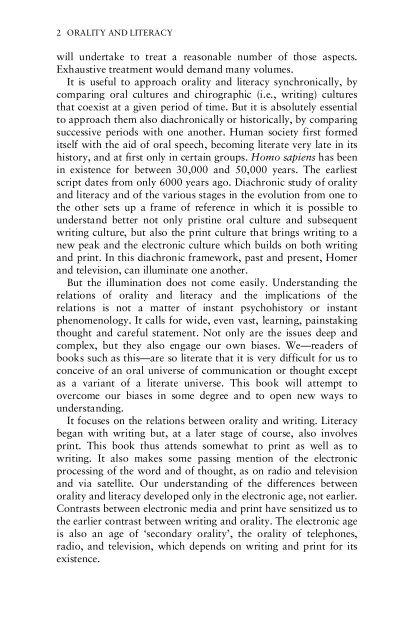Orality and Literacy: The Technologizing of the Word - Monoskop
Orality and Literacy: The Technologizing of the Word - Monoskop
Orality and Literacy: The Technologizing of the Word - Monoskop
You also want an ePaper? Increase the reach of your titles
YUMPU automatically turns print PDFs into web optimized ePapers that Google loves.
2 ORALITY AND LITERACY<br />
will undertake to treat a reasonable number <strong>of</strong> those aspects.<br />
Exhaustive treatment would dem<strong>and</strong> many volumes.<br />
It is useful to approach orality <strong>and</strong> literacy synchronically, by<br />
comparing oral cultures <strong>and</strong> chirographic (i.e., writing) cultures<br />
that coexist at a given period <strong>of</strong> time. But it is absolutely essential<br />
to approach <strong>the</strong>m also diachronically or historically, by comparing<br />
successive periods with one ano<strong>the</strong>r. Human society first formed<br />
itself with <strong>the</strong> aid <strong>of</strong> oral speech, becoming literate very late in its<br />
history, <strong>and</strong> at first only in certain groups. Homo sapiens has been<br />
in existence for between 30,000 <strong>and</strong> 50,000 years. <strong>The</strong> earliest<br />
script dates from only 6000 years ago. Diachronic study <strong>of</strong> orality<br />
<strong>and</strong> literacy <strong>and</strong> <strong>of</strong> <strong>the</strong> various stages in <strong>the</strong> evolution from one to<br />
<strong>the</strong> o<strong>the</strong>r sets up a frame <strong>of</strong> reference in which it is possible to<br />
underst<strong>and</strong> better not only pristine oral culture <strong>and</strong> subsequent<br />
writing culture, but also <strong>the</strong> print culture that brings writing to a<br />
new peak <strong>and</strong> <strong>the</strong> electronic culture which builds on both writing<br />
<strong>and</strong> print. In this diachronic framework, past <strong>and</strong> present, Homer<br />
<strong>and</strong> television, can illuminate one ano<strong>the</strong>r.<br />
But <strong>the</strong> illumination does not come easily. Underst<strong>and</strong>ing <strong>the</strong><br />
relations <strong>of</strong> orality <strong>and</strong> literacy <strong>and</strong> <strong>the</strong> implications <strong>of</strong> <strong>the</strong><br />
relations is not a matter <strong>of</strong> instant psychohistory or instant<br />
phenomenology. It calls for wide, even vast, learning, painstaking<br />
thought <strong>and</strong> careful statement. Not only are <strong>the</strong> issues deep <strong>and</strong><br />
complex, but <strong>the</strong>y also engage our own biases. We—readers <strong>of</strong><br />
books such as this—are so literate that it is very difficult for us to<br />
conceive <strong>of</strong> an oral universe <strong>of</strong> communication or thought except<br />
as a variant <strong>of</strong> a literate universe. This book will attempt to<br />
overcome our biases in some degree <strong>and</strong> to open new ways to<br />
underst<strong>and</strong>ing.<br />
It focuses on <strong>the</strong> relations between orality <strong>and</strong> writing. <strong>Literacy</strong><br />
began with writing but, at a later stage <strong>of</strong> course, also involves<br />
print. This book thus attends somewhat to print as well as to<br />
writing. It also makes some passing mention <strong>of</strong> <strong>the</strong> electronic<br />
processing <strong>of</strong> <strong>the</strong> word <strong>and</strong> <strong>of</strong> thought, as on radio <strong>and</strong> television<br />
<strong>and</strong> via satellite. Our underst<strong>and</strong>ing <strong>of</strong> <strong>the</strong> differences between<br />
orality <strong>and</strong> literacy developed only in <strong>the</strong> electronic age, not earlier.<br />
Contrasts between electronic media <strong>and</strong> print have sensitized us to<br />
<strong>the</strong> earlier contrast between writing <strong>and</strong> orality. <strong>The</strong> electronic age<br />
is also an age <strong>of</strong> ‘secondary orality’, <strong>the</strong> orality <strong>of</strong> telephones,<br />
radio, <strong>and</strong> television, which depends on writing <strong>and</strong> print for its<br />
existence.

















